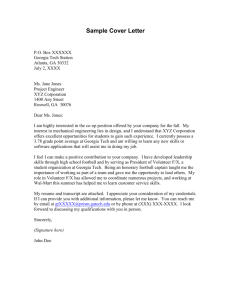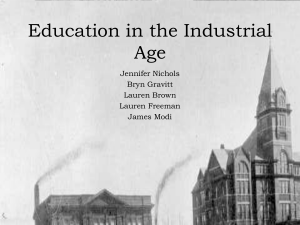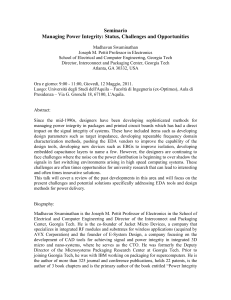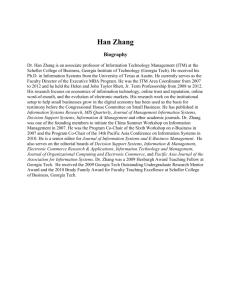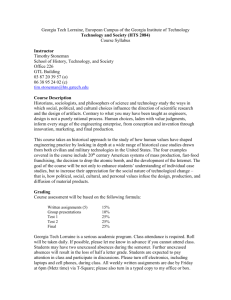Document - Georgia Tech Research Institute
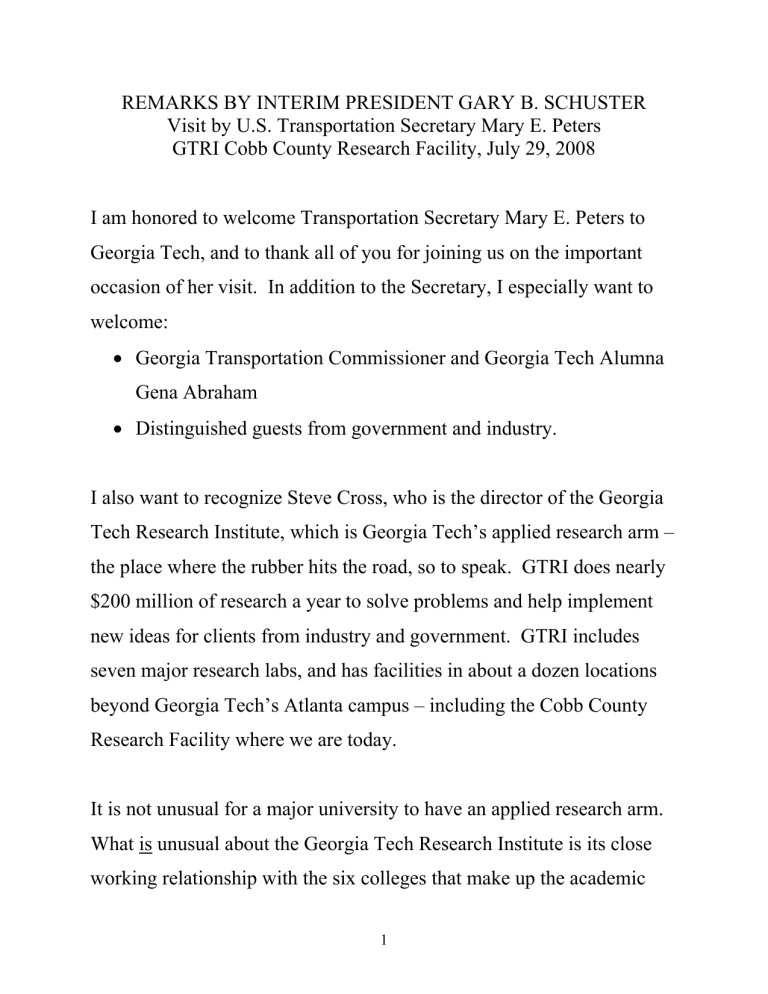
REMARKS BY INTERIM PRESIDENT GARY B. SCHUSTER
Visit by U.S. Transportation Secretary Mary E. Peters
GTRI Cobb County Research Facility, July 29, 2008
I am honored to welcome Transportation Secretary Mary E. Peters to
Georgia Tech, and to thank all of you for joining us on the important occasion of her visit. In addition to the Secretary, I especially want to welcome:
• Georgia Transportation Commissioner and Georgia Tech Alumna
Gena Abraham
• Distinguished guests from government and industry.
I also want to recognize Steve Cross, who is the director of the Georgia
Tech Research Institute, which is Georgia Tech’s applied research arm – the place where the rubber hits the road, so to speak. GTRI does nearly
$200 million of research a year to solve problems and help implement new ideas for clients from industry and government. GTRI includes seven major research labs, and has facilities in about a dozen locations beyond Georgia Tech’s Atlanta campus – including the Cobb County
Research Facility where we are today.
It is not unusual for a major university to have an applied research arm.
What is unusual about the Georgia Tech Research Institute is its close working relationship with the six colleges that make up the academic
1
side of Georgia Tech. Georgia Tech is nationally recognized for its exceptional abilities in technology transfer and in driving economic development, and one of the keys to our success is the excellence of
GTRI and its close connection to the academic colleges.
As a whole, Georgia Tech conducts about a half-billion dollars of research a year – by far the most of any university in the state. Our research endeavors are organized around major interdisciplinary thrusts that address some of the greatest challenges and most intractable problems facing our nation and the world. One of the broad thrust areas on which we are focused is energy and environmental sustainability, and much our work in this arena has a direct bearing on transportation.
More specifically, our work in energy focuses on efficiency, conservation and new sources, and all three of these areas have significance for transportation. At the heart of our efforts to improve efficiency is our Combustion Lab, which is located on the Georgia Tech campus in Midtown Atlanta. But important components of our work in conservation and new energy sources are located here at the Cobb
County Research Facility.
The wind tunnel, for example, is an important tool that allows Bob
Englar and his team to take proven aerodynamics technology developed
2
for jet plane wings and apply it to tractor trailer trucks to help them conserve fuel.
Their goal is to reduce the drag on 18-wheelers by at least a third, perhaps even as much as half, which would improve their fuel efficiency by 12 percent or more. A one percent improvement in fuel economy in the U.S. heavy truck fleet conserves 200 million gallons of fuel. So a 12 percent improvement means saving more than 2 billion gallons of fuel.
At the same time Bob Englar and his team are improving the outside of the vehicle, Tom Fuller and his team in the GTRI Center for Innovative
Fuel Cell and Battery Technology are working on improvements under the hood.
The fuel cell is the next new energy source for transportation. Both
Honda and Toyota are road-testing fuel-cell cars, which are much more efficient than today’s hybrids. And last year Georgia Tech successfully flew the largest hydrogen fuel cell-powered aircraft to date. But there is no question that fuel cell technology can be improved even more with new materials and designs, and that is the goal of the GTRI Center for
Innovative Fuel Cell and Battery Technology.
3
These exciting research endeavors here at the GTRI Cobb Research
Facility are just a few examples of the many transportation research projects underway at Georgia Tech. They cover a wide range from developing emission-free vehicles to designing logistics systems that move people and goods more efficiently.
Unfortunately, there is no silver bullet for the complex web of intertwined problems facing transportation. Rather, there is a need for a comprehensive approach that addresses multiple moving parts at the same time. That is what we are working on at Georgia Tech. And we are very pleased and proud to be a partner with both the U.S.
Department of Transportation and the Georgia Department of
Transportation in solving problems and designing and implementing new ideas and technologies.
Mary E. Peters also has a tremendous wealth of expertise in transportation. She was nominated to be U.S. Secretary of
Transportation by President George W. Bush on September 5, 2006, and her credentials were so formidable that the U.S. Senate quickly confirmed her appointment.
She has worked in transportation for more than two decades, beginning her career in the Arizona Department of Transportation, and working her
4
way up to become director of this state agency. Next she became head of the Federal Highway Administration. And just prior to becoming
Transportation Secretary, she was the national director for transportation policy and consulting at HDR, Inc., a major engineering firm.
As Secretary of Transportation, she heads a federal agency with 60,000 employees and a budget of $70 billion. And she oversees all modes of transportation on land, on water, and in the air.
Over the course of her career, she has developed a reputation as a problem-solver, a champion of transportation safety, and an advocate for the efficient, effective use of taxpayers’ dollars.
It is a great honor to welcome Secretary Peters to Georgia Tech, and I am pleased to introduce her to you at this time.
5
